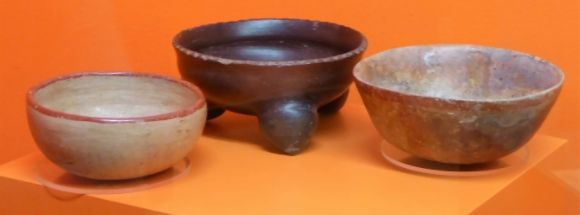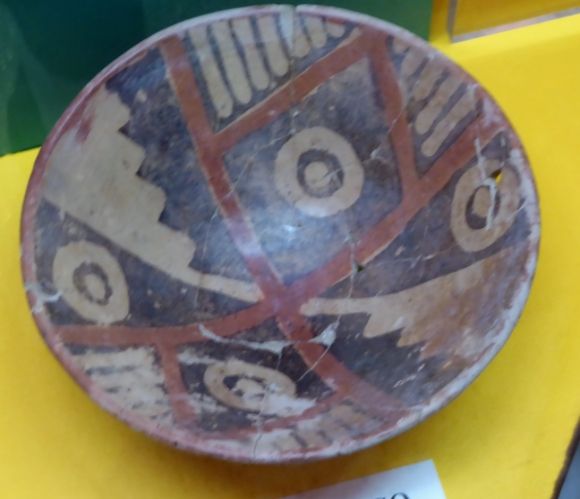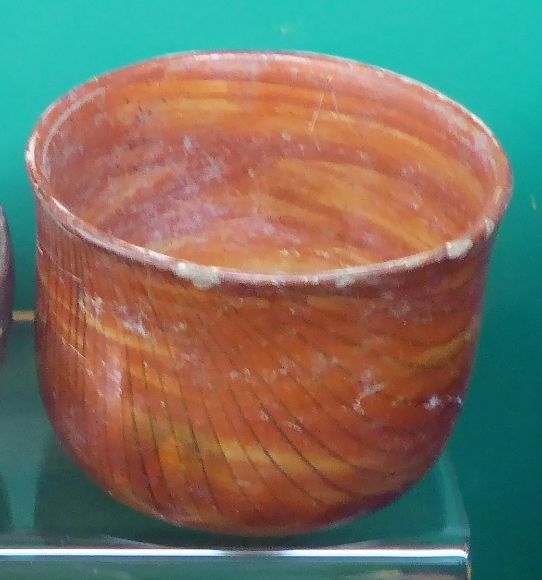The San Bernardino County Museum in Redlands, California, includes displays of archaeological artifacts from Western Mexico. Western Mexico includes the modern states of Colima, Guanajuato, Jalisco, Michoacan, Nayarit, and Sinaloa.

One of the archaeological features within this region are shaft tombs. Shaft tombs by 300 BCE are associated with circular architecture. There is a central circular altar which is ringed by platforms on which there are residential or temple structures. Michael Coe and Rex Koontz, in their book Mexico: From the Olmec to the Aztecs, report:
“These monumental concentric circles are found illustrated in the tomb offerings, where the circles form the stage for elaborate feasting ceremonies and other rituals. The actual circles are often associated with monumental ball courts, the latter also illustrated in the ceramic sculptures, in some of the most life-like renderings of the athletic ceremony to come out of Mesoamerica.”
According to the Museum display:
“The shaft tombs of Western Mexico contained graved goods such as these statues. Often they were in pairs, male and female. It is suggested that they represented the Grandmother and Grandfather, who guided the soul of the deceased to the Afterlife. They also had Guards for safety in the Afterlife.”
Archaeologists suggest that the symbolism in the shaft-tomb art is characteristic of shamanistic rituals and funerary rituals. The art work in the shaft-tombs also shows the existence of political and/or social hierarchies.
With regard to the structure of the shaft-tombs, the tomb excavated at Huitzilapa in Jalisco is 21 feet deep and was cut down through the center of an elite residential structure. There were two chambers at the bottom of the shaft and each chamber contained the remains of three individuals with a rich variety of grave offerings. The tomb was constructed for the burial of high-ranking individuals. The other five individuals in the tomb—two adult females and three adult males—had died earlier and their bodies prepared and preserved as funerary bundles. With the the burial of the elite male, the bundlers were placed in the tomb with him.
With regard to the geographic range of the shaft-tombs, Michael Coe and Rex Koontz report:
“Outside the heartland, in the states of Jalisco, Colima, and Nayarit, only much smaller shaft tombs and simple pit burials are found, also with ceramic sculpture and other offerings, suggesting that there was a regional hierarchy centered on the Volcano of Tequila region.”
In their Encyclopedia of Ancient Mesoamerica, Margaret Bunson and Stephen Bunson write:
“Ceramics from Western Mexico during the Formative Period reflect individuality and skill. The region is believed to have as many as 15 separate archaeological zones.”
In general, Mesoamerican history prior to the European invasion is divided into several periods: Formative (Preclassic, Protoclassic) from 2,000 BCE to 250 CE; Classic from 250 CE to 900 CE; and Preclassic from 900 CE until the Spanish conquest.
Shown below are some of the Western Mexican artifacts displayed at the San Bernardino County Museum.
 The small bowl shown above is from the Classic period. The four snakes on the bowl may represent the four major directions.
The small bowl shown above is from the Classic period. The four snakes on the bowl may represent the four major directions.




Colima
 The pot shown above is the the Late Preclassic to Early Classic period.
The pot shown above is the the Late Preclassic to Early Classic period.
 Post classic pottery is shown above.
Post classic pottery is shown above.
 Shown above is a replica of a postclassic dog sculpture.
Shown above is a replica of a postclassic dog sculpture.
 Shown above are some Protoclassic dog images.
Shown above are some Protoclassic dog images.
 Shown above are Protoclassic pieces.
Shown above are Protoclassic pieces.
Jalisco


 Shown above is a Protoclassic resist ware bowl.
Shown above is a Protoclassic resist ware bowl.
 Shown above is a Protoclassic effigy figure.
Shown above is a Protoclassic effigy figure.
 Shown above is a Late Classic ladle.
Shown above is a Late Classic ladle.
Nayarit
 The ceramics shown above are from the Protoclassic in coastal Nayarit.
The ceramics shown above are from the Protoclassic in coastal Nayarit.
 Shown above is a bowl from the Classic period.
Shown above is a bowl from the Classic period.



